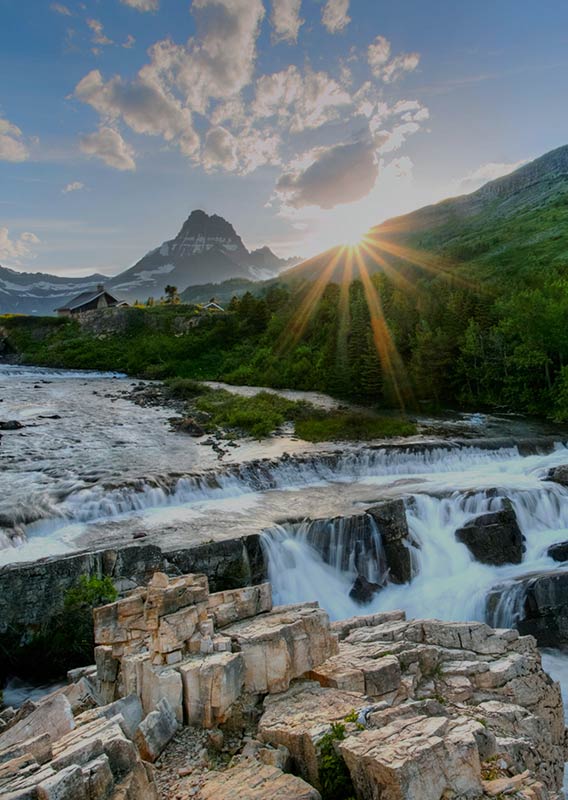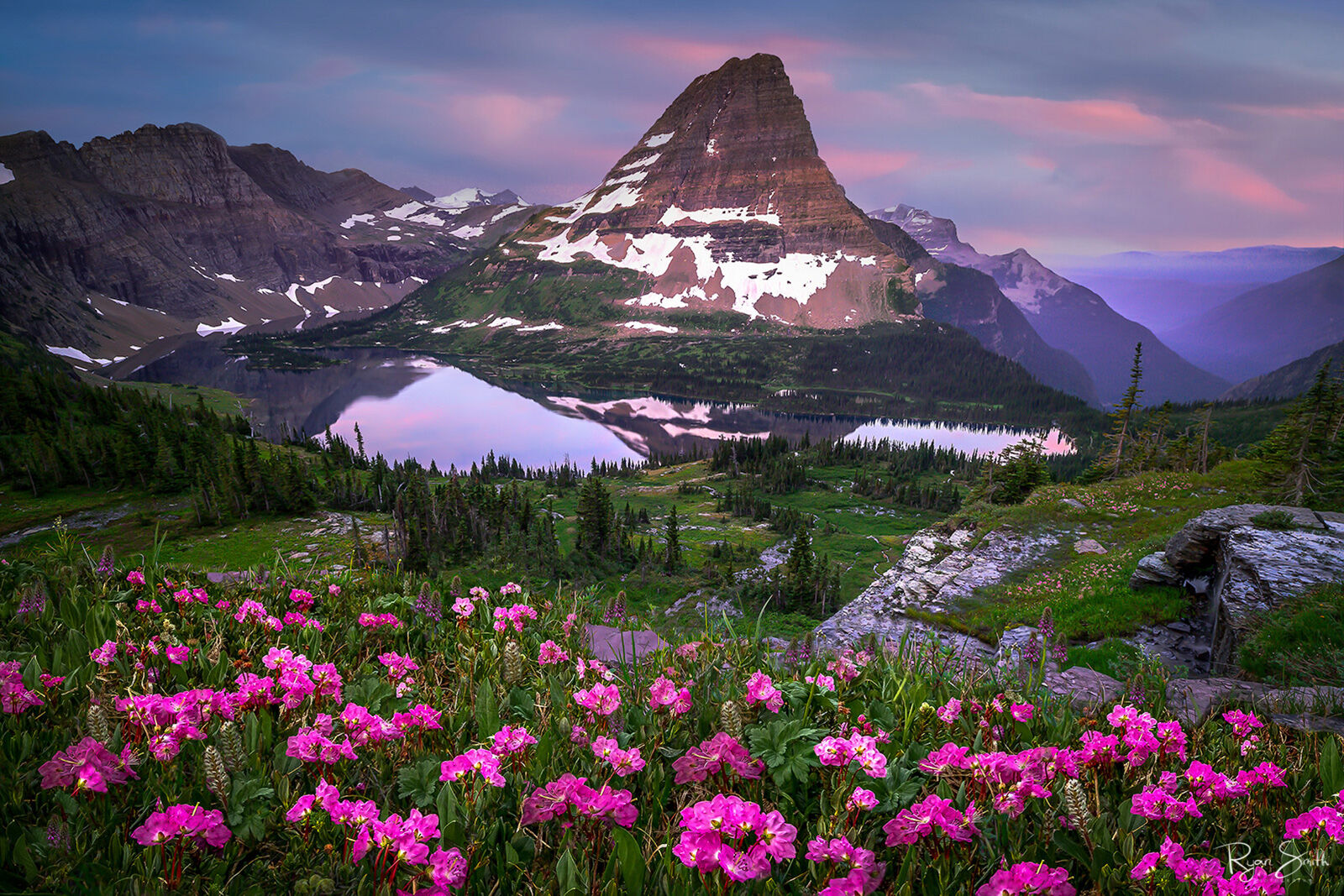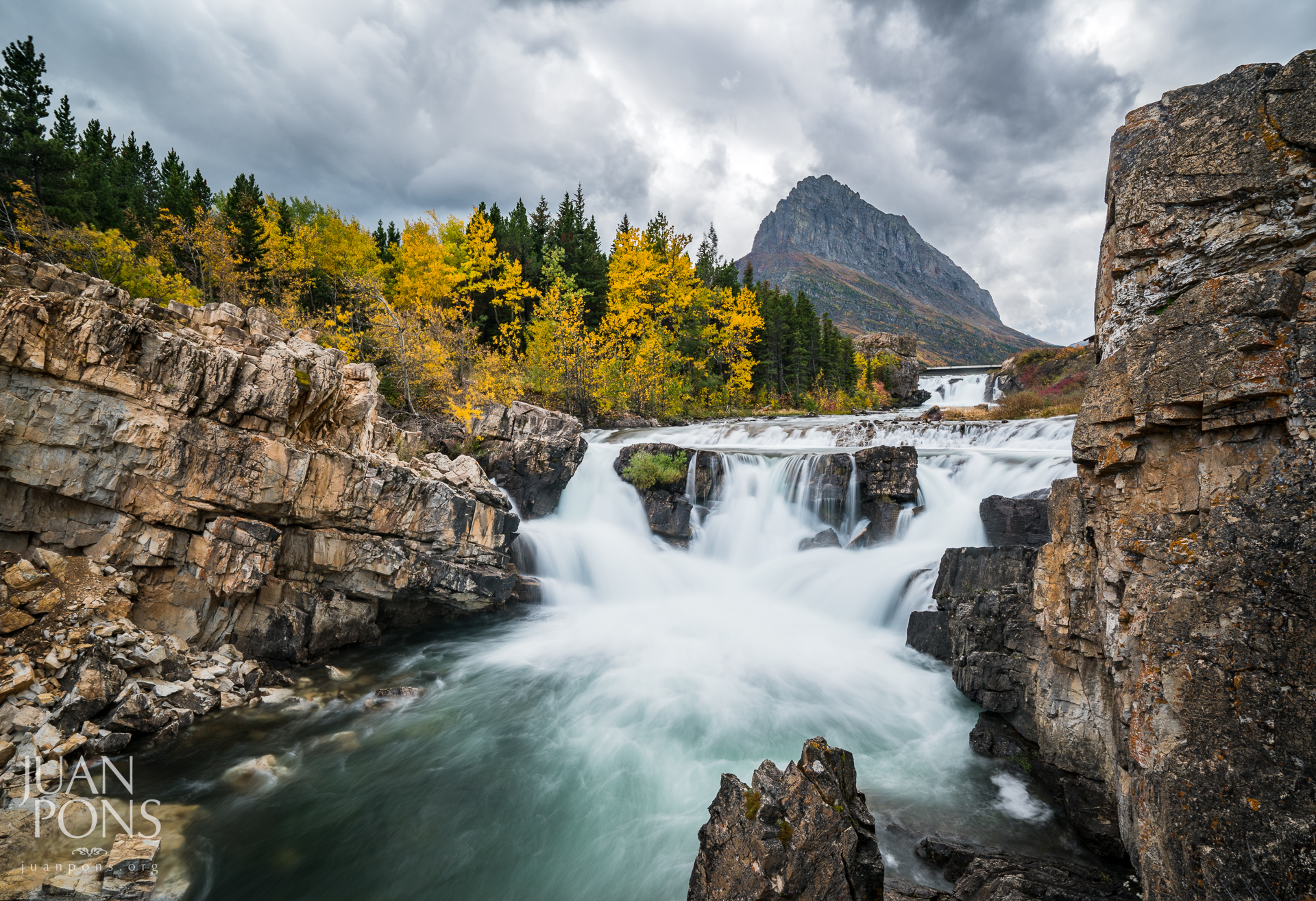Nestled in the pristine wilderness of Montana, USA, Glacier National Park stands as a testament to nature’s grandeur and untamed beauty. Revered as the “Crown of the Continent,” this national park is a sanctuary of towering peaks, pristine lakes, and diverse ecosystems. As one of the crown jewels in the National Park System, Glacier beckons adventurers to explore its breathtaking landscapes and discover the wonders that have earned it a place among the world’s most cherished natural treasures.
Encompassing over a million acres of pristine wilderness, Glacier National Park is a living tapestry of natural wonders. Majestic mountains, including the iconic peaks of the Continental Divide, punctuate the horizon, their snow-capped summits reaching towards the heavens. Blanketed by dense forests, alpine meadows, and glacial valleys, the park invites exploration into its diverse and awe-inspiring ecosystems.

The park’s namesake, the glaciers, has sculpted the landscape over thousands of years. Though their numbers have diminished due to climate change, those that remain are awe-inspiring. Iconic glaciers like Grinnell and Jackson gleam like frozen rivers of ice, nestled amidst the rugged terrain. These glacial formations not only define the park’s geography but also serve as a reminder of the delicate balance between nature and climate.
Winding its way through the heart of Glacier National Park, the Going-to-the-Sun Road is a marvel of engineering and a gateway to unparalleled scenic vistas. Carved into the mountainside, this historic road offers breathtaking panoramas of glaciers, alpine meadows, and the pristine waters of glacial lakes. Each turn reveals a new chapter in the visual symphony that unfolds, making it a must-experience journey for any visitor.

Glacier National Park is a haven for biodiversity, supporting a wide array of plant and animal life. From elusive mountain goats navigating sheer cliffs to grizzly bears roaming through subalpine meadows, the park provides a habitat for species uniquely adapted to its rugged environment. Wildflowers paint the landscape with bursts of color, creating a vibrant contrast against the rugged backdrop.
For outdoor enthusiasts, Glacier National Park is a recreational paradise. Hiking trails crisscross the terrain, leading adventurers through pristine wilderness and to jaw-dropping viewpoints. The park’s pristine lakes offer opportunities for boating and fishing, while the backcountry beckons backpackers with the promise of solitude and serenity. As a designated International Peace Park, Glacier also shares its beauty with Canada’s Waterton Lakes National Park, forming a transboundary haven for nature lovers.

Beyond its natural wonders, Glacier National Park holds cultural significance for the Blackfeet Nation and the Salish and Kootenai tribes. Visitors can explore the rich history of the area through interpretive programs, historic lodges, and the presence of Native American communities. The park’s commitment to preserving cultural heritage adds depth to the visitor experience.
While Glacier National Park invites exploration, it also underscores the importance of conservation. Climate change poses a significant threat to the park’s glaciers, ecosystems, and wildlife. The imperative to preserve this natural legacy for future generations is evident, calling on visitors and stewards alike to cherish, protect, and advocate for the delicate balance of the “Crown of the Continent.”

In the heart of Montana’s wilderness, Glacier National Park stands as a testament to the majesty of the natural world. From its iconic glaciers to the diverse ecosystems that call it home, the park offers an immersive experience into the untamed beauty of the “Crown of the Continent.” As visitors traverse its trails, breathe in the crisp mountain air, and witness the grandeur of the landscape, they become part of a legacy that underscores the importance of preserving nature’s wonders for generations to come. Discover Glacier National Park, where the spirit of the wilderness reigns supreme, and the crown gleams with timeless allure.
Nestled on the border between Canada and Montana, USA, Glacier National Park stands as a testament to the grandeur of nature and the enduring legacy of the ice age. Named for the remnants of ancient glaciers that sculpted its landscapes, this national park is a pristine wilderness, a living museum of geological wonders, and a haven for outdoor enthusiasts seeking to explore the untamed beauty of the Northern Rockies.

Glacier National Park is a geological masterpiece, shaped over millennia by the powerful forces of ice and time. The park’s iconic landscapes, including rugged mountains, deep valleys, and pristine lakes, bear the unmistakable fingerprints of ancient glaciers that once blanketed the region. Today, these remnants stand as silent witnesses to the colossal forces that shaped the earth during the ice age.
Situated on the northern border of Montana and extending into Canada’s British Columbia and Alberta provinces, Glacier National Park covers over a million acres of diverse ecosystems. Its northern boundary merges seamlessly with Canada’s Waterton Lakes National Park, forming the world’s first International Peace Park—a testament to the harmonious coexistence of two nations and their commitment to preserving natural wonders.

Beyond its glacial landscapes, Glacier National Park is a thriving ecosystem boasting unparalleled biodiversity. Alpine meadows, dense forests, and crystal-clear lakes provide habitat for a diverse array of wildlife, including grizzly bears, mountain goats, elk, and elusive gray wolves. The park’s pristine wilderness serves as a haven for both common and endangered species, making it a vital refuge for ecological conservation.
One of the park’s highlights is the iconic Going-to-the-Sun Road, a feat of engineering that traverses the heart of Glacier National Park. This scenic marvel winds its way through mountain passes, showcasing breathtaking vistas of glacial valleys, alpine meadows, and towering peaks. The journey along this road is a sensory feast, offering unparalleled views that leave an indelible mark on the hearts of those who traverse its twists and turns.

Glacier National Park, with its awe-inspiring landscapes and ecological diversity, serves as a living laboratory for understanding the impacts of climate change. Tragically, the park’s glaciers, once numerous, are rapidly receding due to global warming. The delicate balance between preservation and adaptation to a changing climate becomes a focal point, emphasizing the urgency of worldwide conservation efforts.
For outdoor enthusiasts, Glacier National Park is a recreational haven. Hiking trails crisscross the terrain, leading adventurers to pristine alpine lakes, hidden waterfalls, and panoramic overlooks. Backpacking, wildlife watching, and boat excursions offer immersive experiences, allowing visitors to connect with the park’s wild essence and foster a deep appreciation for its natural wonders.

Glacier National Park, named for the remnants of glacial forces that shaped its landscapes, stands as a testament to the enduring beauty and fragility of Earth’s natural wonders. From its majestic peaks to its vibrant ecosystems, the park invites visitors to embark on a journey through time, exploring the remnants of the ice age and contemplating the delicate balance between preservation and adaptation. As Glacier National Park continues to captivate the hearts of those who wander through its untamed landscapes, it remains an eternal testament to the wonders of our planet’s geological history.
Nestled in the northern reaches of Montana, where the rugged beauty of the United States meets the sprawling landscapes of Canada, Glacier National Park stands as an embodiment of pristine wilderness and natural grandeur. This expansive sanctuary, often referred to as the “Crown of the Continent,” is not just a geographic wonder but a testament to the harmonious coexistence of two nations sharing the bounty of the great outdoors.

Glacier National Park’s strategic location makes it a geographical marvel. Stretching across the border between northern Montana and Canada, the park becomes a seamless blend of landscapes, where snow-capped mountains, pristine lakes, and ancient glaciers form a captivating tapestry. This unique positioning adds an international flavor to the park, creating an environment where nature transcends political boundaries.
The heart of Glacier National Park is a symphony of rugged peaks and deep valleys. Majestic mountains, draped in blankets of evergreen forests, command attention against the vast blue sky. The landscape is punctuated by glacial valleys carved out over centuries, where crystal-clear lakes mirror the towering peaks, creating reflections that amplify the park’s sense of majesty.

No exploration of Glacier National Park is complete without a venture along the famed Going-to-the-Sun Road. This engineering marvel takes visitors on a winding odyssey through the heart of the park, offering breathtaking views of glacial valleys, dense forests, and alpine meadows. As the road ascends, the landscape unfolds like a living canvas, painting an unforgettable picture of natural splendor.
Glaciers, the eponymous jewels of the park, are living remnants of a bygone era. Though climate change has taken its toll, the remaining glaciers—such as Grinnell Glacier—stand as stoic witnesses to the park’s glacial past. Hiking to these icy wonders becomes a pilgrimage, allowing visitors to connect with the Earth’s history and witness the ongoing impact of environmental changes.

Beyond the glaciers, Glacier National Park boasts diverse ecosystems that contribute to its designation as a UNESCO World Biosphere Reserve. The park’s varied environments, from subalpine meadows to dense old-growth forests, provide a haven for a plethora of wildlife. Grizzly bears, mountain goats, elk, and an array of bird species thrive in this untouched wilderness, creating a delicate ecological balance.
The land that constitutes Glacier National Park carries deep cultural significance for Native American tribes, including the Blackfeet, Salish, and Kootenai. Their traditions, stories, and spiritual practices are woven into the fabric of the park, adding layers of cultural richness to the natural tapestry. Visitors can engage with this cultural heritage, recognizing that the land is not just a scenic backdrop but a living testament to indigenous history.

As Glacier National Park straddles the U.S.-Canada border, it serves as a testament to international cooperation in preserving natural wonders. The park’s ecological health depends on collaborative efforts between the two nations to ensure the continuity of its beauty for future generations. It stands as a beacon of environmental stewardship, encouraging the world to recognize the importance of transnational conservation.
In the grandeur of Glacier National Park, where the boundaries between nations blur and nature takes center stage, visitors find not just a destination but an immersive experience in the wonders of the wild. As a bridge between the U.S. and Canada, the park beckons all who seek to explore its untamed beauty, offering a sanctuary where the rugged landscapes of northern Montana seamlessly merge with the pristine wilderness of Canada. It stands as an enduring testament to the harmonious coexistence of nature and nations, inviting all to witness and preserve the majesty of the Crown of the Continent.

In the northern reaches of Montana, just across the border from the enchanting landscapes of Waterton Lakes National Park in Canada, a unique collaboration unfolds—a shared vision of preserving natural beauty and fostering international harmony. Here, two nations converge to create the Waterton-Glacier International Peace Park, a transcendent sanctuary that exemplifies the union of nature and diplomacy.
Nestled on opposite sides of the U.S.-Canada border, Glacier National Park and Waterton Lakes National Park seamlessly meld into each other, transcending political divisions. This harmonious blending of landscapes gives rise to the Waterton-Glacier International Peace Park, where nature takes precedence over boundaries, and the serenity of the wilderness becomes a testament to the potential for unity across borders.

Waterton Lakes National Park, situated in Canada, and Glacier National Park in the United States, engage in a captivating dance of ecosystems. The rugged peaks, pristine lakes, and diverse wildlife of each park extend their influence across the border, forming a symbiotic relationship that culminates in an unparalleled display of natural wonder. This seamless coexistence illustrates the power of collaboration in preserving ecological diversity.
The collaboration between Glacier and Waterton Lakes National Parks extends beyond symbolic unity. Both nations actively engage in sustainable tourism and conservation efforts to protect the delicate ecosystems within the Peace Park. Through joint initiatives, such as wildlife management and habitat restoration, they ensure that future generations can continue to enjoy the pristine beauty of this international treasure.

The Waterton-Glacier International Peace Park isn’t merely a celebration of nature; it’s a platform for cultural exchange. Interpretive programs, events, and collaborations between park authorities provide visitors with insights into the rich history, traditions, and indigenous cultures that have shaped the region. This cultural exchange fosters a deeper understanding of the interconnectedness of humanity and nature.
As stewards of this transboundary treasure, the United States and Canada demonstrate the spirit of international cooperation. The ongoing commitment to preserve the Waterton-Glacier International Peace Park serves as a model for the world—an example of how shared natural resources can become a catalyst for diplomacy and understanding, promoting peace across borders.




